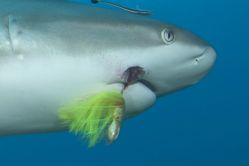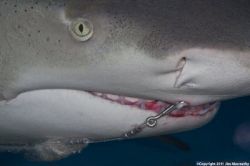Yesterday I descended for a dive just to watch my newly-trained instructor in front of guests. The dive went very well. The crew, weather, visibility and guests were just wonderful, and I couldn’t have called for a better day. I was even graced by the presence of some divers I have known and dived with for 10-20 years. What I did not like was seeing sharks swimming around with new hooks in their mouths, again.
Although I despise seeing hooks on the animals, I also know that sharks will follow any fishing vessel and try to collect their catch before it’s hauled on board. Sharks will always be sharks, and they will from time to time show up with new hooks. Most of the hooks will be small enough so that I know they were not intended for sharks, but others are big enough with a thick enough lure that I worry about the shark’s safety.
I had heard reports of a boat fishing right over Shark Junction, and I realized that they had gone there to fish sharks, against the law, against the local community and against everything that a dive site stands for on the island. They had been prepared for a big catch: the fishing hooks were new and attached by metal to thick lines.
 In either case I start my work to remove the hooks. After years of working with the same sharks, I have noticed that a shark showing up with a new hook will come in rather carefully. Some of them will continually swim around the feeding ground, but never approach close enough to be fed. I can’t think for a shark, but it seems to me that the pain of the hook prevents them from trying to feed.
In either case I start my work to remove the hooks. After years of working with the same sharks, I have noticed that a shark showing up with a new hook will come in rather carefully. Some of them will continually swim around the feeding ground, but never approach close enough to be fed. I can’t think for a shark, but it seems to me that the pain of the hook prevents them from trying to feed.
My first step is to start regaining their trust. It may take more then one dive for that animal to feed. Sometimes they swim close enough to have the fish right in front of their nose, but they keep swimming and totally avoid it. Usually towards the end of the dive I concentrate on convincing the shark to take the fish again.
When they finally take the first bite, they are usually fast and weary, speeding away and coming back with reluctance. It takes two to three fishes to finally have the shark confident enough to join the group normally.
That does not mean the animal is perfectly comfortable. I have observed on countless occasions the painful reaction of the shark after trying to bite the fish. It is difficult to describe, but there is a marked difference in the opening of the mouth and the taking of the bait compared to a shark without a hook.
 If I manage to get the shark to continue coming back for food, I then start the process of removal. In a few cases I use tonic immobility, putting the shark to “sleep” while they are resting on my lap and removing the hook in one swift movement. It causes the shark to wake up and swim away, but leaves me with the hook in my hand.
If I manage to get the shark to continue coming back for food, I then start the process of removal. In a few cases I use tonic immobility, putting the shark to “sleep” while they are resting on my lap and removing the hook in one swift movement. It causes the shark to wake up and swim away, but leaves me with the hook in my hand.
Most times though the hooks are removed on the fly, as the shark is swimming towards me. I try to get the shark to open its mouth with a rapid movement of my hand, tricking it into thinking I am about to feed it, and then I push and pull to free the hook.
There are enormous difficulties. Some of the hooks are easy, some very hard. Often the tiny barb at the end of the hook is stuck on the tough skin of the animal, and refuses to budge. Also my hand is covered in chainmail, so grasping the hook is hard, and as soon as the shark feels a push or a tug on the hook, it rapidly swims away.
With some I will have to start the process all over again, realizing it’s too soon to try to remove the hook. Some will come back though, over and over again in tighter and tighter circles, slowing down their swimming until the hook finally comes out.
There are a few that have to come out the other way around, because they have already pierced the side of the mouth. With these I usually let the hook stick to my finger, and pull it out as the shark slides by.
It is long and repetitive work, and there are only a few pictures of the process because it is a difficult action to capture. But there are certainly pictures of the final result: a happy Cristina with a removed hook in her hands.
Cristina Zenato is Head of Diving at UNEXSO, Grand Bahama Island, a world-renowned shark diver, and a member of the Women Divers’ Hall of Fame. Cristina is sharing her considerable knowledge of and experience in diving with sharks through a new Shark Savers' blog series. This is the sixth in the series.